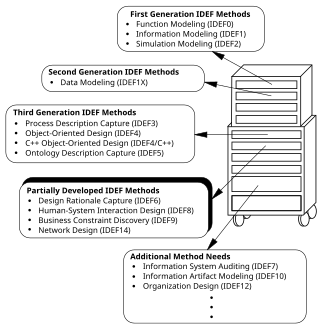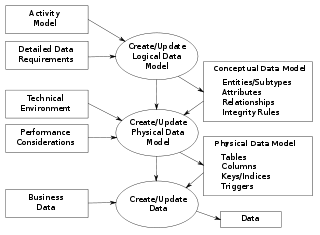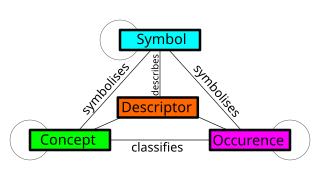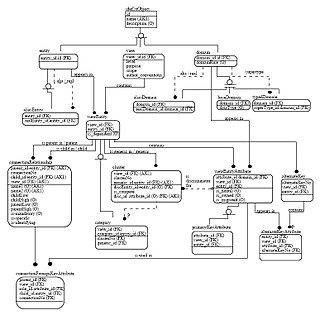In information science, an ontology encompasses a representation, formal naming, and definitions of the categories, properties, and relations between the concepts, data, or entities that pertain to one, many, or all domains of discourse. More simply, an ontology is a way of showing the properties of a subject area and how they are related, by defining a set of terms and relational expressions that represent the entities in that subject area. The field which studies ontologies so conceived is sometimes referred to as applied ontology.
Software design is the process of conceptualizing how a software system will work before it is implemented or modified. Software design also refers to the direct result of the design process – the concepts of how the software will work which consists of both design documentation and undocumented concepts.
A modeling language is any artificial language that can be used to express data, information or knowledge or systems in a structure that is defined by a consistent set of rules. The rules are used for interpretation of the meaning of components in the structure of a programming language.

IDEF, initially an abbreviation of ICAM Definition and renamed in 1999 as Integration Definition, is a family of modeling languages in the field of systems and software engineering. They cover a wide range of uses from functional modeling to data, simulation, object-oriented analysis and design, and knowledge acquisition. These definition languages were developed under funding from U.S. Air Force and, although still most commonly used by them and other military and United States Department of Defense (DoD) agencies, are in the public domain.

Data modeling in software engineering is the process of creating a data model for an information system by applying certain formal techniques. It may be applied as part of broader Model-driven engineering (MDE) concept.
A functional software architecture (FSA) is an architectural model that identifies enterprise functions, interactions and corresponding IT needs. These functions can be used as a reference by different domain experts to develop IT-systems as part of a co-operative information-driven enterprise. In this way, both software engineers and enterprise architects can create an information-driven, integrated organizational environment.

A metamodel is a model of a model, and metamodeling is the process of generating such metamodels. Thus metamodeling or meta-modeling is the analysis, construction, and development of the frames, rules, constraints, models, and theories applicable and useful for modeling a predefined class of problems. As its name implies, this concept applies the notions of meta- and modeling in software engineering and systems engineering. Metamodels are of many types and have diverse applications.

An information model in software engineering is a representation of concepts and the relationships, constraints, rules, and operations to specify data semantics for a chosen domain of discourse. Typically it specifies relations between kinds of things, but may also include relations with individual things. It can provide sharable, stable, and organized structure of information requirements or knowledge for the domain context.
In information science, an upper ontology is an ontology that consists of very general terms that are common across all domains. An important function of an upper ontology is to support broad semantic interoperability among a large number of domain-specific ontologies by providing a common starting point for the formulation of definitions. Terms in the domain ontology are ranked under the terms in the upper ontology, e.g., the upper ontology classes are superclasses or supersets of all the classes in the domain ontologies.
Simple Knowledge Organization System (SKOS) is a W3C recommendation designed for representation of thesauri, classification schemes, taxonomies, subject-heading systems, or any other type of structured controlled vocabulary. SKOS is part of the Semantic Web family of standards built upon RDF and RDFS, and its main objective is to enable easy publication and use of such vocabularies as linked data.
In philosophy, the term formal ontology is used to refer to an ontology defined by axioms in a formal language with the goal to provide an unbiased view on reality, which can help the modeler of domain- or application-specific ontologies to avoid possibly erroneous ontological assumptions encountered in modeling large-scale ontologies.
Gellish is an ontology language for data storage and communication, designed and developed by Andries van Renssen since mid-1990s. It started out as an engineering modeling language but evolved into a universal and extendable conceptual data modeling language with general applications. Because it includes domain-specific terminology and definitions, it is also a semantic data modelling language and the Gellish modeling methodology is a member of the family of semantic modeling methodologies.

Enterprise modelling is the abstract representation, description and definition of the structure, processes, information and resources of an identifiable business, government body, or other large organization.

A semantic data model (SDM) is a high-level semantics-based database description and structuring formalism for databases. This database model is designed to capture more of the meaning of an application environment than is possible with contemporary database models. An SDM specification describes a database in terms of the kinds of entities that exist in the application environment, the classifications and groupings of those entities, and the structural interconnections among them. SDM provides a collection of high-level modeling primitives to capture the semantics of an application environment. By accommodating derived information in a database structural specification, SDM allows the same information to be viewed in several ways; this makes it possible to directly accommodate the variety of needs and processing requirements typically present in database applications. The design of the present SDM is based on our experience in using a preliminary version of it. SDM is designed to enhance the effectiveness and usability of database systems. An SDM database description can serve as a formal specification and documentation tool for a database; it can provide a basis for supporting a variety of powerful user interface facilities, it can serve as a conceptual database model in the database design process; and, it can be used as the database model for a new kind of database management system.
Enterprise engineering is the body of knowledge, principles, and practices used to design all or part of an enterprise. An enterprise is a complex socio-technical system that comprises people, information, and technology that interact with each other and their environment in support of a common mission. One definition is: "an enterprise life-cycle oriented discipline for the identification, design, and implementation of enterprises and their continuous evolution", supported by enterprise modelling. The discipline examines each aspect of the enterprise, including business processes, information flows, material flows, and organizational structure. Enterprise engineering may focus on the design of the enterprise as a whole, or on the design and integration of certain business components.

In computer science, information science and systems engineering, ontology engineering is a field which studies the methods and methodologies for building ontologies, which encompasses a representation, formal naming and definition of the categories, properties and relations between the concepts, data and entities of a given domain of interest. In a broader sense, this field also includes a knowledge construction of the domain using formal ontology representations such as OWL/RDF. A large-scale representation of abstract concepts such as actions, time, physical objects and beliefs would be an example of ontological engineering. Ontology engineering is one of the areas of applied ontology, and can be seen as an application of philosophical ontology. Core ideas and objectives of ontology engineering are also central in conceptual modeling.
Contemporary ontologies share many structural similarities, regardless of the ontology language in which they are expressed. Most ontologies describe individuals (instances), classes (concepts), attributes, and relations.

IDEF3 or Integrated DEFinition for Process Description Capture Method is a business process modelling method complementary to IDEF0. The IDEF3 method is a scenario-driven process flow description capture method intended to capture the knowledge about how a particular system works.

Method engineering in the "field of information systems is the discipline to construct new methods from existing methods". It focuses on "the design, construction and evaluation of methods, techniques and support tools for information systems development".
Knowledge extraction is the creation of knowledge from structured and unstructured sources. The resulting knowledge needs to be in a machine-readable and machine-interpretable format and must represent knowledge in a manner that facilitates inferencing. Although it is methodically similar to information extraction (NLP) and ETL, the main criterion is that the extraction result goes beyond the creation of structured information or the transformation into a relational schema. It requires either the reuse of existing formal knowledge or the generation of a schema based on the source data.














